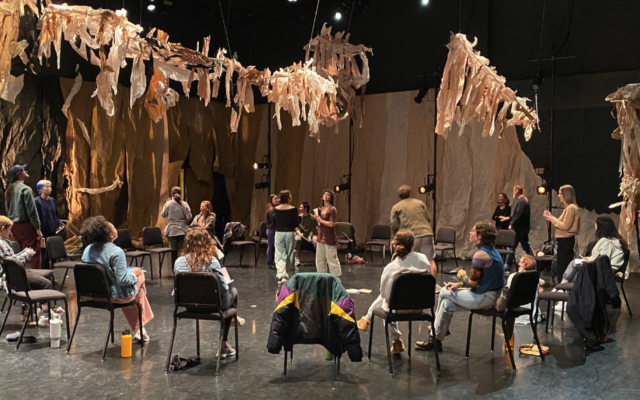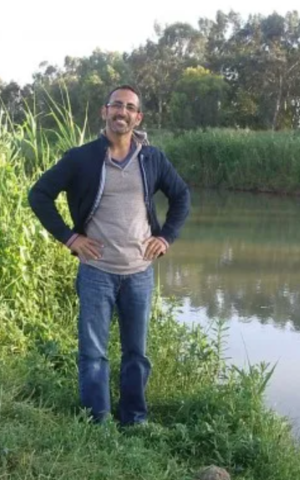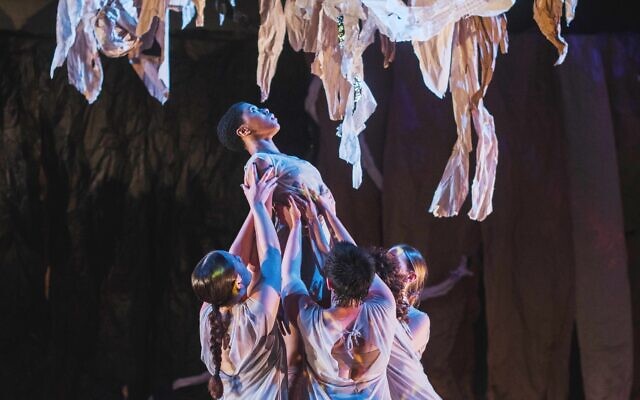Emory Dance Program Examines New Beginnings
Atlanta’s staibdance performs a first look for Ararat, its work in progress.
For inspiration for his latest dance project, Ararat, at Emory University’s Schwartz Center for The Performing Arts, choreographer George Staib has reached back into both contemporary world history and biblical scriptures for his theme.
Staib, who is also a professor of dance practice at Emory, unveiled Ararat as a work in progress on the last weekend in January. He has subtitled the work by his staibdance company, “The Beginning.” Staib believes that there is much to ponder in the idea of celebrating new beginnings, starting with our own life.

“Starting again, you know, whether it’s a failed relationship or having a baby, how much of your identity do you maintain and what new identity do you take on when that happens. I’m just so fascinated by this. And especially in this post-pandemic world, when everything stopped, I’m thinking, well, what do we pick up again? What do I want to pick up again?”
Although he is quick to deny that the work is not biblical in its origins, he mentions that the world confronted a new beginning in the Book of Genesis, and the recreation of the world after the waters had receded. Ararat is clearly mentioned as the landing place of Noah’s Ark after The Great Flood in the Book of Genesis. The text mentions that Noah spent 150 days in his ark after the water had gone down “on the seventeenth day of the seventh month the ark came to rest on the mountains of Ararat.”

While there have been differences of opinion about where those mountains may be located, those who have had an interest in exploring biblical history have concentrated their attention around an area in northeastern Turkey, where the snow-covered, 17,000-foot summit of an extinct volcano called Mount Ararat is located. Interestingly, it is only about 400 miles from the epicenter of a more recent cataclysmic event, the Turkish earthquake on Feb. 6 that has so far has claimed tens of thousands of lives.
Mount Ararat is seen as a sacred mountain by those who live just across the Turkish border in Armenia. There is a legend that Mount Ararat is the cradle of our present-day world. Armenians believe themselves to be the first humans to appear after The Flood.
Staib is of Armenian ancestry. His family has had several new beginnings, as they moved from India to Iran before ending up in Glendale and Burbank in California, which he says has been such a magnet for his people. New beginnings for him have always had particularly relevance.

“There’s this hunger to find a place, after starting over and over. You then layer that with personal tragedies or losses. Humans, just as we all do, have many beginnings and sometimes the beginning turn into an assimilation question. And this is why I find the Jewish faith so noble and beautiful. There is something that Jews hold on to regardless of where they might end up.”
According to Staib, Armenians and Jews are related not only by their respective diasporas but by the tragedies they have endured over the last century, something he understands particularly well from having made several extended visits to Israel studying dance in Tel Aviv.
The Ararat performance seeks to memorialize the Armenian Holocaust of 1915 and 1916 which is said to have resulted in the deaths of hundreds of thousands of Armenians and their forced exile. The United States Holocaust Memorial Museum estimates that as many as 1.2 million Armenians died during the genocide by the Turks of the Ottoman Empire.
Thirty years later, the world learned the full horror of the Nazi crimes of World War II, when one concentration camp after another was liberated. The first night’s performance of Ararat on Jan. 27 coincided with the UN’s International Holocaust Remembrance Day, the date in 1944 when Auschwitz Birkenau was finally captured by the advancing Soviet Army. Expressing the deep feelings that come with new beginnings, Staib points out, works particularly well in dance.
“So the value for me, of working with it through movement, stirs up the same kind of incomprehensible and unidentifiable ‘aha’ moment that we encounter when we’re beginning something. In working with the dancers or the musicians or whatever it might be, we collaborate to find a way to recreate that moment of feeling, almost like on an unsteady boat without an anchor.”
Staib considers the January performances of Ararat – The Beginning as a work in progress, which is supported, in part, by a grant from the National Endowment for the Humanities. A formal premiere is scheduled in November.
- Arts and Culture
- Local
- Bob Bahr
- Ararat
- Emory University
- Schwartz Center for The Performing Arts
- George Staib
- The Beginning
- Book of Genesis
- Noah’s Ark
- The Great Flood
- Turkey
- Armenia
- Glendale
- Burbank
- Armenian Holocaust of 1915
- United States Holocaust Memorial Museum
- International Holocaust Remembrance Day
- Auschwitz-Birkenau




comments